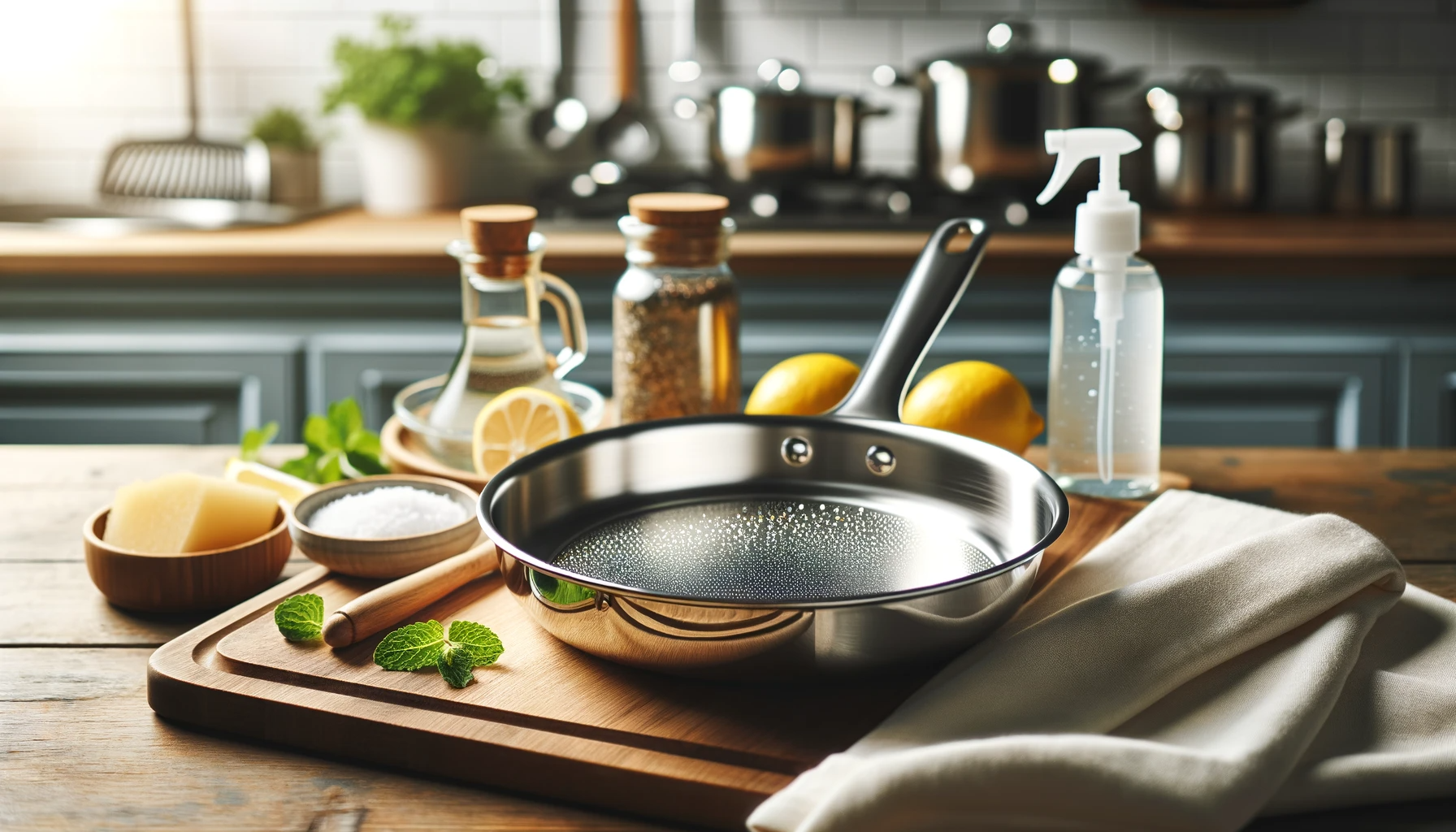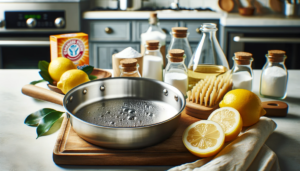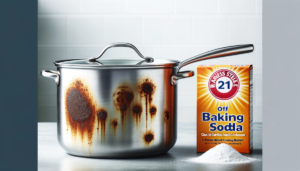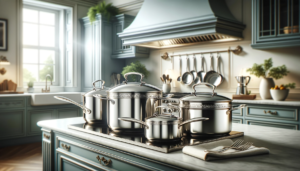Is your stainless steel cookware showing ugly brown stains and pits? Learn what causes pans to lose their rust-free shine and how to revive yours.
Stainless steel resists corrosion thanks to a passive chromium layer, but scratches and harsh environments can disrupt this protection over time, allowing rust.
From cookware quality to cleaning methods and early pitting signs, let’s dive into all the ways stainless steel pans start to rust, and how to stop it.
Does Stainless Steel Cookware Rust?
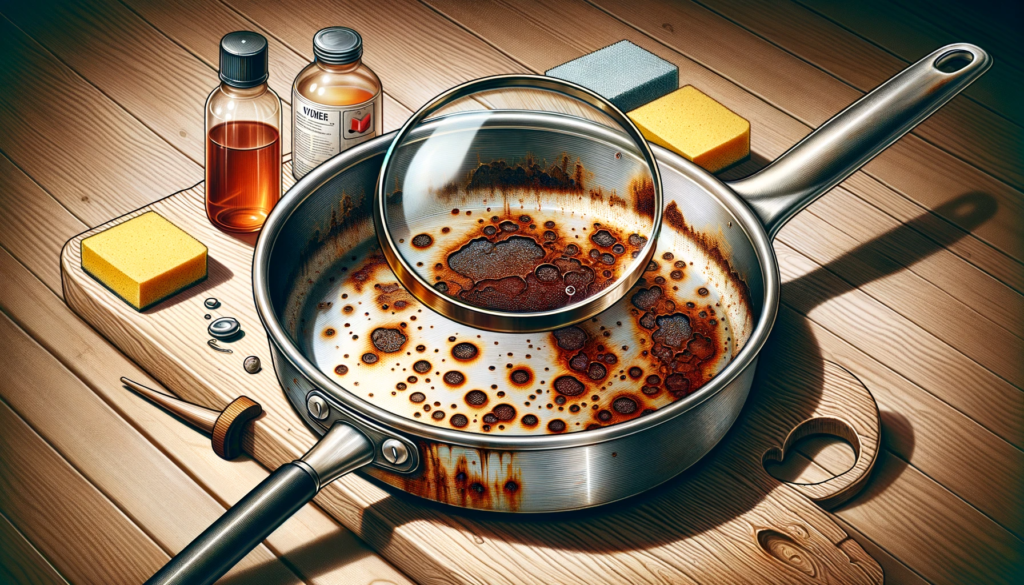
Yes, stainless steel cookware can eventually rust and corrode if not cared for properly.
The chromium in stainless steel forms a passive protective layer that resists rusting.
But this layer can get damaged from scratches, cleaning chemicals, contact with salt, or very high heat over time.
Once this protective chromium oxide barrier gets compromised and underlying steel gets exposed, stainless steel pots and pans will start to exhibit rusting, pits, stains, and permanent discoloration.
So while well-maintained stainless steel is highly rust-resistant thanks to its chromium content, it is not completely immune to rust formation under all conditions indefinitely.
We’ll explore the factors that cause stainless steel pan rusting and how to prevent it in more detail ahead.
What is Stainless Steel?
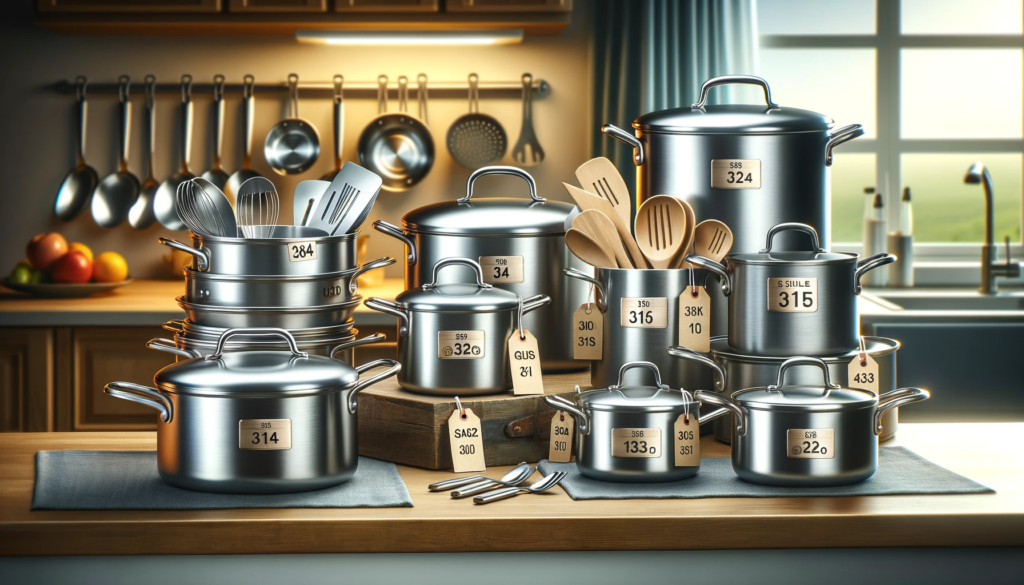
Stainless steel is an alloy, or mixture, of steel with other elements, most importantly chromium.
The addition of chromium creates a thin, transparent, passive layer of chromium oxide on the steel’s surface.
This oxide layer acts as a shield against corrosion, protecting the metal underneath.
Sometimes other elements like nickel or molybdenum are also added to stainless steel, but chromium is the main element that makes stainless steel resistant to corrosion.
The amount of chromium can vary, but stainless steel always has at minimum 10.5% chromium content.
Higher chromium content generally indicates higher corrosion resistance.
There are different grades of stainless steel.
Common grades used for kitchen cookware include 304, 316, and 430.
The major difference among them has to do with corrosion resistance, determined by their alloy composition.
Overall, stainless steel provides good resistance against rust or corrosion compared to other types of steel, while still offering strength, affordability, and ease of fabrication.
This corrosion resistance, along with appearance, durability, and ease of cleaning are some of the main advantages that make stainless steel a popular choice for pots, pans, and various types of cookware used in our kitchens.
Does Stainless Steel Rust?
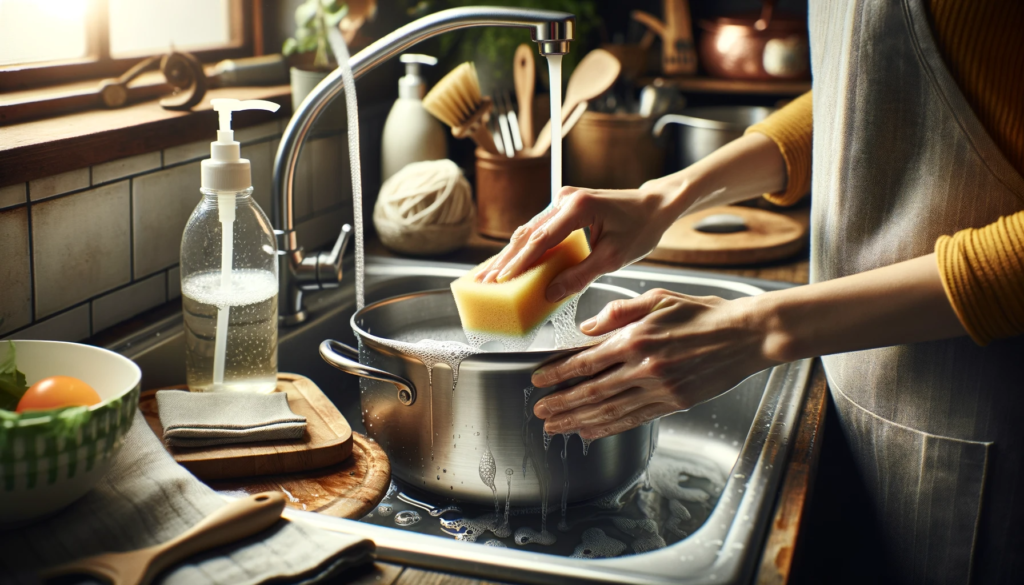
Given stainless steel’s inherent corrosion resistance, a common question that arises is whether stainless steel cookware can actually rust.
The answer is: while the chromium in stainless steel provides excellent protection against rust and corrosion, stainless steel is not 100% impervious to corrosion under all conditions and scenarios.
In other words, stainless steel can experience some forms of corrosion damage given the right (or wrong) circumstances.
The passive chromium oxide layer shields the base metal of stainless steel quite effectively.
But it is possible for this protective coating to get compromised or damaged in certain ways.
If the chromium oxide layer gets damaged by deep scratches, cracks, or other defects that expose the underlying steel surface, then the metal becomes more prone to corrosion.
Defects in the cookware material itself can also lead to loss of corrosion protection.
Impurities or uneven distribution of chromium can make stainless steel less resistant to corrosion in those weaker areas.
So in summary, stainless steel itself does not rust readily, but if defects or damage exists in the protective layer, then corrosion can begin in those regions where the base metal gets exposed to air and moisture.
When Can Stainless Steel Cookware Rust?
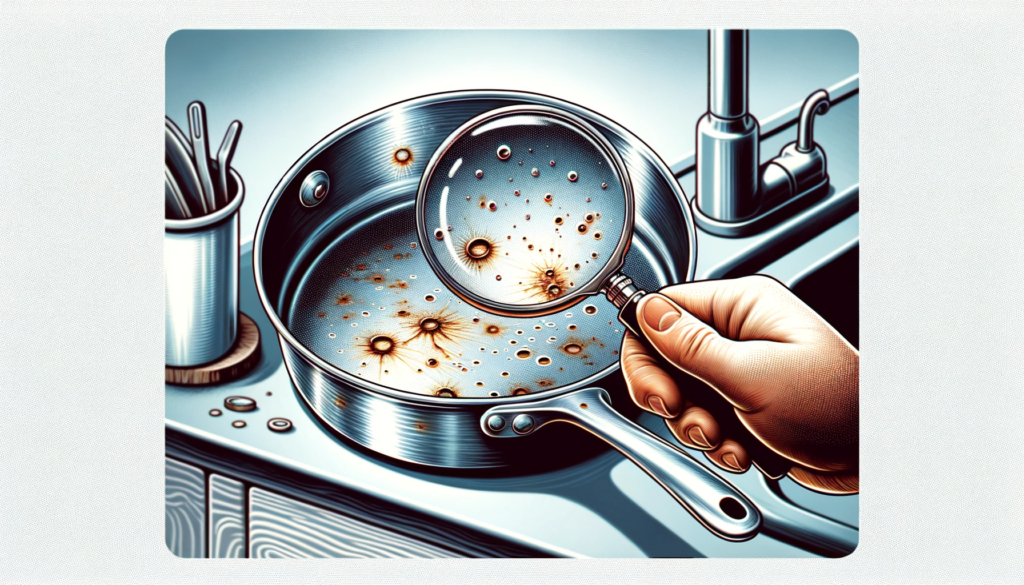
Stainless steel pots and pans can start to rust or corrode when:
The Passive Layer is Damaged
As described earlier, the chromium oxide layer shields stainless steel from corrosion.
But this layer can get compromised, allowing oxidation to take place:
Scratches and Cracks:
Surface scratches, cracks, chips, or other physical damage from rough handling or use of abrasive scouring pads can wear away the protective coating, exposing the more vulnerable steel underneath.
Even shallow or hairline scratches make it easier for corrosion to gain a foothold.
Manufacturing Defects:
Imperfections produced during manufacturing like chromium carbide precipitates or micro-fissures, can lead to breakdown of passivity in those regions.
Localized Corrosion:
Impurities in the metal or non-uniform distribution of chromium allows corrosion to occur more easily in some spots compared to others.
This leads to pitting or small holes in the stainless steel surface.
Exposure to Chlorides and Salts
The passive layer on stainless steel can get attacked by chlorides found in water, salt, and bleach.
Sea air and salt water are particularly corrosive due to higher chloride content.
Using cookware at the beach or exposing it to pool chemicals increases likelihood of pitting or staining.
Inadequate Care and Maintenance
Allowing food residue, mineral deposits from water, or soap scum to linger for too long on stainless steel can initiate corrosion by breaking down the protective chromium oxide barrier:
- Burnt on food and grease gets oxidized into harmful compounds.
- Mineral etching from hard water causes corrosion pits and cracks.
- Alkaline properties of baking soda or lye damage passivity.
These common cooking byproducts lower corrosion resistance over time when not cleaned off promptly and thoroughly.
Environmental Factors
Harsh conditions speed up the corrosion process in tiny unprotected crevices of stainless steel:
- Salty sea air causes pitting from chloride exposure.
- Sulphur dioxide and carbon dioxide in air pollution attack stainless steel.
- Very hot temperatures and thermal fluctuations degrade the protective layer.
So while stainless steel itself does not rust, corrosion can happen when the integrity of the protective chrominum oxide layer is disrupted.
Factors that Contribute to Rust
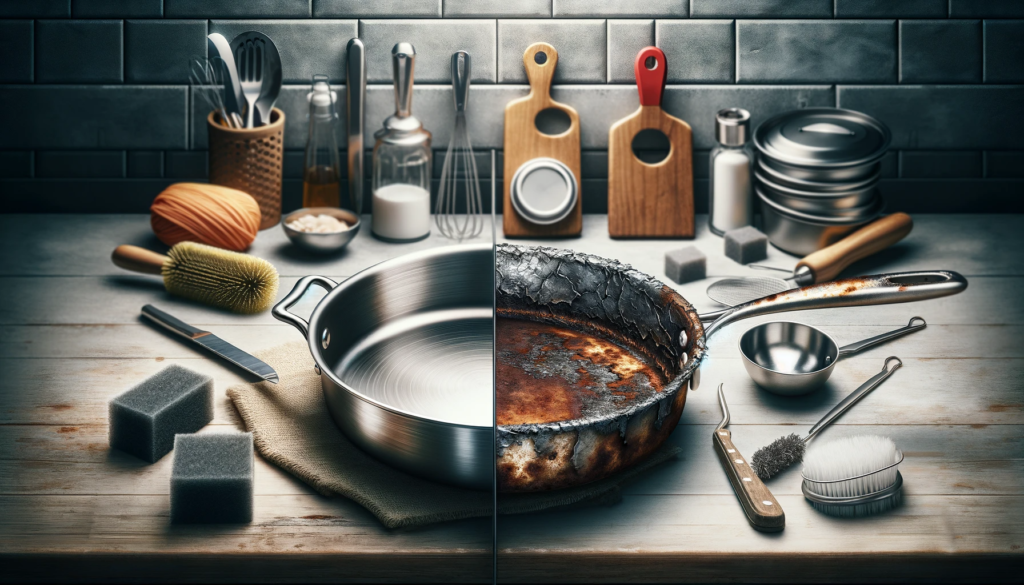
Several interconnected factors influence how corrosion-prone a particular piece of stainless steel cookware might become:
Quality of the Stainless Steel
Higher nickel and molybdenum content, in addition to chromium, enhances corrosion resistance.
More expensive cookware is made using such high-grade stainless steel alloys that better resist scratches, chemical attack, and pitting.
Cheap stainless steel has lower corrosion resistance due to lower chromium levels, inclusions, and other defects.
Quality of Construction
High quality cookware has very fine surface finishes that maintain integrity of the protective oxide layer.
Seamless construction without rivets and joints also reduces crevices where corrosion can initiate.
Smooth, uniform surfaces are less likely to get scratched or allow buildup of deposits.
Low quality pots and pans often have rough surfaces and questionable manufacturing standards, making them more prone to developing defects where corrosion begins.
Usage Conditions and Care
How the cookware gets used and maintained impacts corrosion likelihood more than the quality of the stainless steel itself.
Even expensive cookware eventually pits or corrodes with excessive neglect or abuse:
- Banging cookware around daily eventually damages the protective layer despite good stainless steel quality, initiating rust.
- High mineral content in tap water, esp containing chlorides, accelerates corrosion over time with inadequate cleaning.
So while premium stainless steel has very good innate corrosion resistance, it still requires a minimum level of proper care and maintenance to realize its full lifetime.
Environmental Factors
As noted previously, a highly corrosive environment contributes to progressive deterioration of any grade of stainless steel:
- Coastal locations with sea salt accelerate the pitting process.
- Industrial areas with sulphur dioxide cause rapid oxidation.
So the operating environment makes a difference in speed of corrosion onset.
In summary, whether made using good or inferior stainless steel, cookware that faces physical damage, chemical attack, buildup of minerals and grease deposits, high temperatures, thermal shocks and/or highly corrosive environments will likely pit and fail prematurely regardless of material grade.
How to Prevent Rust on Stainless Steel
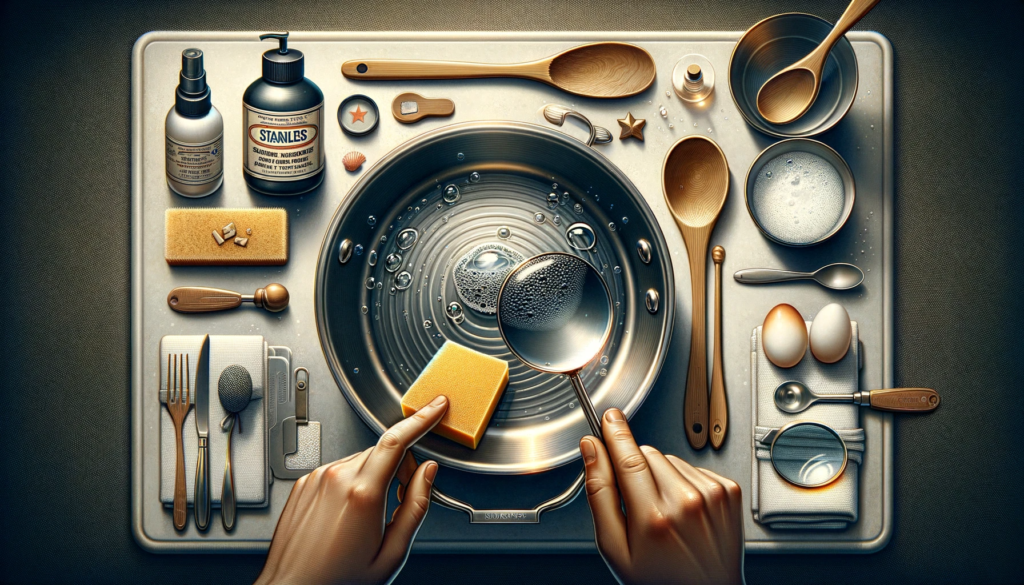
Though stainless steel is highly rust resistant, corrosion resistance is never 100% even in the best cookware.
However, a few simple precautions help prevent common risk factors for corrosion:
Handle with Care
Being metal, stainless steel pots and pans still dent and scratch.
Dropping them or banging utensils carelessly eventually damages that protective passive layer:
- Avoid metal utensils which can scratch.
Use wood, silicone instead. - Set down pots gently rather than dropping.
- Don’t stack cookware roughly.
Pans should have protectors between when stacked. - Inspect regularly for small dents, cracks or scratches forming – buff out immediately before they worsen.
Clean Properly
After cooking, promptly wash cookware thoroughly with mild dish soap and soft non-abrasive pad or brush:
- Soak pans first to loosen residue, then handwash gently.
- Use baking soda or vinegar instead of harsh chemical cleaners which can damage passive films over time with residual alkalinity or chlorine compounds.
- Fully rinse off all soap residue with clean water afterward.
- Towel dry immediately so water spots don’t form.
Standing moisture allows corrosion reactions.
Thorough cleaning prevents mineral and grease deposits which can initiate pitting or cracking when interacting with stainless steel over prolonged time while accumulating.
Consider Cookware Protectants
Applying a barrier coating sealant enhances corrosion resistance – commercial products like Stainless Steel Magic or Cameo provide an invisible layer of protection from fingerprints, grease splatter and water spots during daily cooking use over time.
Re-applying protectants periodically replaces the protective lubricant layer lost naturally through washing.
However, nothing substitutes proper stainless steel cookware use and timely cleaning.
Check for Early Signs
Periodically inspect cookware surface and underside for early pitting or corrosion signs – brownish discolored dots or hazy bands indicate the passive film is deteriorating and rusting has initiated in those spots:
- Catching it early allows re-polishing the areas to remove corrosion if surface roughness is still largely intact.
- Once deep cratered pitting occurs with roughness and flaking, cookware damage is likely irreversible.
Signs of Rust or Corrosion

How do you know if stainless steel pans are starting to corrode and rust? Some subtle early warning signs as well as more obvious indicators:
Discolored Spots
Brownish or reddish discoloration, especially if localized rather than uniform across the whole surface.
This suggests corrosion reactions are taking place in those stained areas at higher rates.
Orange deposits also indicate active rust formation.
Pitting and Roughness
Tiny holes or indentation points to loss of metal through pitting – areas where base metal gets exposed to moisture and oxygen.
These pits have rougher textures than the surrounding intact surface.
Clustered pitting suggests serious crevice corrosion is underway.
Rust Stains
Reddish brown staining in lines or smudges signals rusting of iron particles from other sources now accumulating on the surface.
This attraction happens because stainless steel surface changes charge when rust reactions initiate.
Staining can eventually become severe pitting if left unchecked.
Flaking Deposits
Whitish, loose mineral type deposits which flake off from surfaces during washing or scratching with fingernail.
This suggests chloride salts and corrosive oxides are building up through crevices to corrode the underlying metal.
These visual markers can indicate corrosion problems ahead if noticed and not addressed early by re-conditioning the protective layer.
Initially minor surface defects quickly graduate into permanent erosion of the stainless steel itself.
When to Discard Rusting Cookware
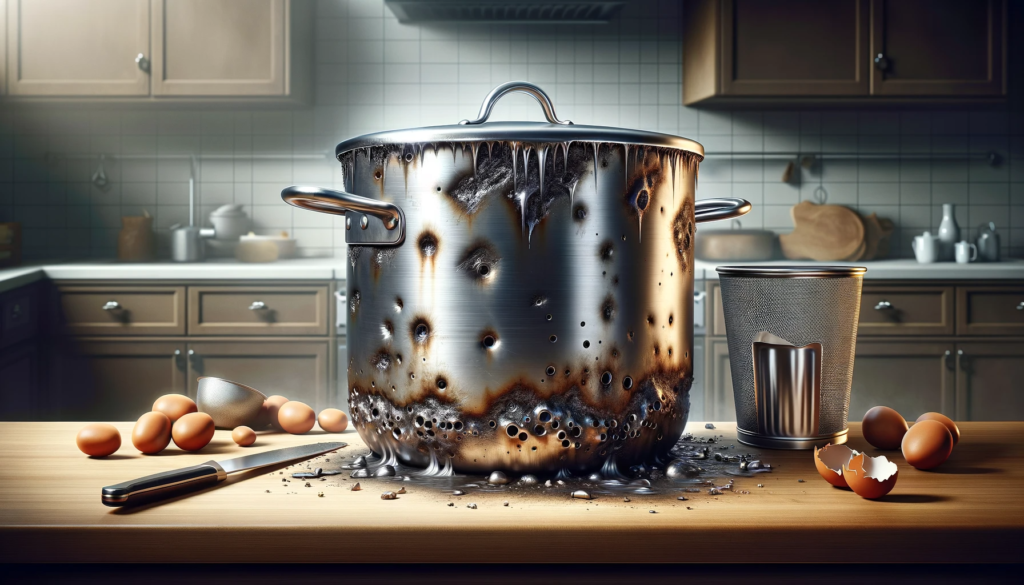
At what point should you throw away a stainless steel pot or pan that is showing corrosion damage?
Recurring Rust Problems
If rust keeps returning frequently despite re-polishing and surface conditioning, the passive layer is too far gone.
Tiny overlooked crevices have likely developed into permanently enlarged defects churning out rust continuously.
Fighting a losing battle with endless recurring rust is good reason to retire corrosion-prone cookware.
Visible Pitting
Deep, enlarged and darkened etch pits cannot be scrubbed away – these cavities with rough metal and loose debris actively advance deterioration.
Surface pitting eats away too much iron and chromium, severely undermining corrosion resistance regardless of remedial efforts.
Accumulated Scratches
Abundant criss-cross scratches, even if superficial individually, collectively add up as harbors where corrosion reactions persist.
Visible etched markings into the metal itself mean the protective passive barrier is no longer viable.
Attempting to polish out huge swathes of abrasions is pointless.
At some point, trying to revive extensively damaged cookware becomes impractical and even hazardous as metallic or other contamination can start leaching into food.
Rust-riddled pans also become increasingly difficult to keep clean and sterile for safe cooking.
Conclusion
In conclusion, quality stainless steel is highly resistant to rust when properly cared for.
But no material is completely immune to corrosion with enough neglect or abuse.
By understanding what causes stainless steel cookware to rust and learning preventative care, you can leverage its intrinsic rust-resistant properties for long-lasting performance.
Handle with care and your stainless steel pots will resist tarnishing for years of cooking enjoyment.
